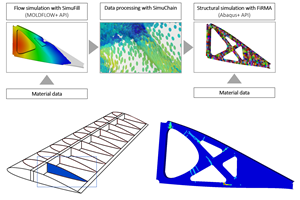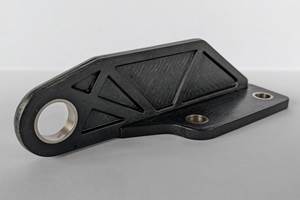Purging conservatism from composite designs
Craig Collier, president of Collier Research Group (Hampton, Va.) says cross-discipline software interconnectivity will unlock the full potential of composites.
Although the composites industry is maturing, overbuilt designs are still the rule rather than the exception. The departmental divisions between designers, analysts and manufacturing engineers — not any single person or process — are the culprits. For example, designers generally aren’t required to know if their design can carry specific loads, and stress analysts aren’t trained in the fine points of shop-floor fabrication. Also, there is no real-time design iteration among these three disciplines, just a series of data handoffs. Without good communication and an iterative product-development process, composite designs easily can be 15 to 20 percent overweight and, as a result, material cost is unnecessarily high.
In recent years, computer-aided engineering (CAE) software has evolved in parallel with composite materials and manufacturing technology. As material systems have advanced, so have the capabilities to virtually simulate and optimize designs. Finite element analysis (FEA) has grown increasingly accurate in calculating loads and predicting stresses; CAD and other composites software have ever more sophisticated means to orchestrate the manufacturing process. But departmental disconnects between computer-aided tools have prevented the industry from fully realizing the potential of composite materials.
A composite product is born in the design department. From there, the design is passed to the structural engineering group, which determines the laminate thickness and layup angles for design details, such as bolted joints, to ensure that the component can carry real-world loads. But when engineers can’t predict failure loads with high confidence, especially when using damage tolerance stress/strain allowables, weight almost always gets added at this stage.
The revised, load-adjusted design is then returned to the designers, who alter it further, based on input from manufacturing engineers. They simplify layup and fabrication by examining processes, such as how tape-laying machines will actually manufacture the part. To make the design more manufacturable, additional weight — typically a lot — is added. For example, without an optimization tool, designers often avoid the complex problem of ply interleaving or coverage patterns by simply adding continuous plies.
Further, designers and analysts are often out of sync, working independently and even making changes on different versions of the same design. If rigorous controls are implemented, they create a territorial mentality. Models, then, are owned by groups, and it often takes a favor, rather than a standard protocol, to get an update. Bookkeeping standards in terms of material properties, IDs, numbering systems, and specs, can differ between groups, contributing to a bumpy process flow.
Design-isolation problems do not end there. In companies with hundreds of engineers, getting data out of CAD or specialized composites software and into an FEA solver or pre- or postprocessor is a common engineering hurdle. The same is true of trying to import analysis data into the CAD system.
Data disconnect and design departmentalization can be addressed by building connectivity among the tools that are spread throughout the company. Composite analysis software, for example, can serve as a CAE interface and data exchange hub. By iterating in a continuous loop with FEA solvers, analysts can automate the analysis, determine required sizes and laminate specs from a stress need, using corrected stress/strain allowables, and then calculate the most manufacturable layup and optimize the design, with substantial weight savings. As a connecting hub, the software can streamline data interchange via customized and compatible interfaces with CAD (e.g., CATIA or Pro-E), finite element modelers (e.g., PATRAN or FEMAP) and composite software tools (e.g., FiberSIM or Simulayt), eliminating hours of manual calculations, offline spreadsheet development and model remeshing.
When design and analysis departments are linked for smooth data flow, designs are more easily iterated. If more manufacturing considerations are brought to the analysis and optimization stages early on, designs become more manufacturable. As CAD and FEA tools become more closely interconnected, and as specialized composite analysis is added to the mix, there will be fewer design shortcomings, negative margins of safety or inadequate safety factors. And that 15 to 20 percent weight reduction for composite structures doesn’t need to be left on the industry table. Given today’s affordability issues, this alone is huge.
Explosive growth of composites in a variety of industries is just around the corner. But around that same corner, the walls that separate design disciplines are still high. Composite-specific software tools have already opened some design doors, helped automate manufacturing and cut costs. But greater cross-discipline software interconnectivity will give companies looking for breakthroughs built on composites the ability to unlock the material’s full potential.
Related Content
Improving carbon fiber SMC simulation for aerospace parts
Simutence and Engenuity demonstrate a virtual process chain enabling evaluation of process-induced fiber orientations for improved structural simulation and failure load prediction of a composite wing rib.
Read MoreOptimizing a thermoplastic composite helicopter door hinge
9T Labs used Additive Fusion Technology to iterate CFRTP designs, fully exploit continuous fiber printing and outperform stainless steel and black metal designs in failure load and weight.
Read MoreThe basics of composite drawing interpretation
Knowing the fundamentals for reading drawings — including master ply tables, ply definition diagrams and more — lays a foundation for proper composite design evaluation.
Read MoreComposite sidewall cover expands options for fire-safe rail components
R&D project by CG Rail explores use of carbon fiber-reinforced thermoplastics and recycled manufacturing scrap to meet fire safety, weight and volume targets.
Read MoreRead Next
“Structured air” TPS safeguards composite structures
Powered by an 85% air/15% pure polyimide aerogel, Blueshift’s novel material system protects structures during transient thermal events from -200°C to beyond 2400°C for rockets, battery boxes and more.
Read MoreDeveloping bonded composite repair for ships, offshore units
Bureau Veritas and industry partners issue guidelines and pave the way for certification via StrengthBond Offshore project.
Read MoreVIDEO: High-volume processing for fiberglass components
Cannon Ergos, a company specializing in high-ton presses and equipment for composites fabrication and plastics processing, displayed automotive and industrial components at CAMX 2024.
Read More










.jpg;maxWidth=300;quality=90)










